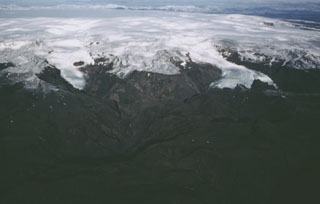Report on Katla (Iceland) — 31 August-6 September 2016
Smithsonian Institution / US Geological Survey
Weekly Volcanic Activity Report, 31 August-6 September 2016
Managing Editor: Sally Sennert.
Please cite this report as:
Global Volcanism Program, 2016. Report on Katla (Iceland) (Sennert, S, ed.). Weekly Volcanic Activity Report, 31 August-6 September 2016. Smithsonian Institution and US Geological Survey.
Katla
Iceland
63.633°N, 19.083°W; summit elev. 1490 m
All times are local (unless otherwise noted)
The Iceland Met Office (IMO) reported that seismic activity within Katla's caldera had increased in mid-June and then began to decline. On 29 August two earthquakes of about M 4.5 occurred in the NE part of the caldera, the largest earthquakes detected at Katla since 1977. The ensuing swarm that same day produced over 100 earthquakes, the largest of which was M 3.3. Seismicity was low after the swarm had ended.
Throughout the summer, electrical conductivity levels in the Múlakvísl River, which drains from the E side of the Mýrdalsjökull glacier that covers Katla, had remained unusually high, reflecting a constant source of geothermal meltwater. There had also been frequent reports of a sulfur odor close to Múlakvísl; gas measurements near the source of Múlakvísl revealed unhealthy levels of hydrogen sulfide, also indicating high concentrations of geothermal fluids. IMO noted that the recent earthquake activity does not appear to have significantly affected conductivity levels in Múlakvísl.
IMO stated that summertime increases in caldera seismicity are an almost annual occurrence at Katla, often associated with the drainage of geothermal meltwater causing minor floods in glacial rivers from Mýrdalsjökull.
Geological Summary. Katla volcano, located near the southern end of Iceland's eastern volcanic zone, is hidden beneath the Myrdalsjökull icecap. The subglacial basaltic-to-rhyolitic volcano is one of Iceland's most active and is a frequent producer of damaging jökulhlaups, or glacier-outburst floods. A large 10 x 14 km subglacial caldera with a long axis in a NW-SE direction is up to 750 m deep. Its high point reaches 1380 m, and three major outlet glaciers have breached its rim. Although most recorded eruptions have taken place from fissures inside the caldera, the Eldgjá fissure system, which extends about 60 km to the NE from the current ice margin towards Grímsvötn volcano, has been the source of major Holocene eruptions. An eruption from the Eldgjá fissure system about 934 CE produced a voluminous lava flow of about 18 km3, one of the world's largest known Holocene lava flows. Katla has been the source of frequent subglacial basaltic explosive eruptions that have been among the largest tephra-producers in Iceland during historical time and has also produced numerous dacitic explosive eruptions during the Holocene.

